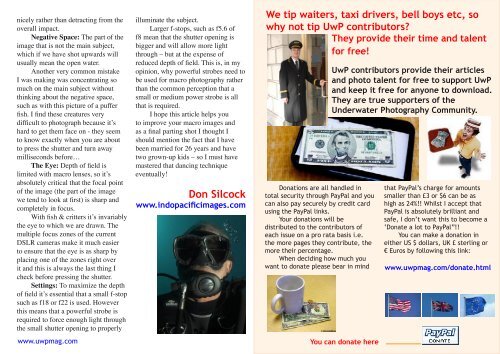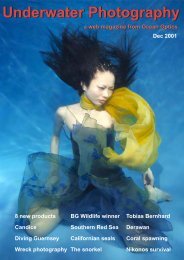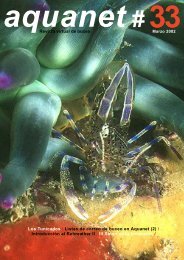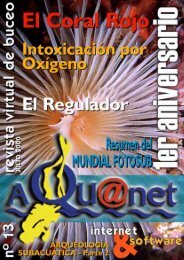Underwater Photography Underwater Photography
Underwater Photography Underwater Photography
Underwater Photography Underwater Photography
Create successful ePaper yourself
Turn your PDF publications into a flip-book with our unique Google optimized e-Paper software.
nicely rather than detracting from the<br />
overall impact.<br />
Negative Space: The part of the<br />
image that is not the main subject,<br />
which if we have shot upwards will<br />
usually mean the open water.<br />
Another very common mistake<br />
I was making was concentrating so<br />
much on the main subject without<br />
thinking about the negative space,<br />
such as with this picture of a puffer<br />
fish. I find these creatures very<br />
difficult to photograph because it’s<br />
hard to get them face on - they seem<br />
to know exactly when you are about<br />
to press the shutter and turn away<br />
milliseconds before…<br />
The Eye: Depth of field is<br />
limited with macro lenses, so it’s<br />
absolutely critical that the focal point<br />
of the image (the part of the image<br />
we tend to look at first) is sharp and<br />
completely in focus.<br />
With fish & critters it’s invariably<br />
the eye to which we are drawn. The<br />
multiple focus zones of the current<br />
DSLR cameras make it much easier<br />
to ensure that the eye is as sharp by<br />
placing one of the zones right over<br />
it and this is always the last thing I<br />
check before pressing the shutter.<br />
Settings: To maximize the depth<br />
of field it’s essential that a small f-stop<br />
such as f18 or f22 is used. However<br />
this means that a powerful strobe is<br />
required to force enough light through<br />
the small shutter opening to properly<br />
illuminate the subject.<br />
Larger f-stops, such as f5.6 of<br />
f8 mean that the shutter opening is<br />
bigger and will allow more light<br />
through – but at the expense of<br />
reduced depth of field. This is, in my<br />
opinion, why powerful strobes need to<br />
be used for macro photography rather<br />
than the common perception that a<br />
small or medium power strobe is all<br />
that is required.<br />
I hope this article helps you<br />
to improve your macro images and<br />
as a final parting shot I thought I<br />
should mention the fact that I have<br />
been married for 26 years and have<br />
two grown-up kids – so I must have<br />
mastered that dancing technique<br />
eventually!<br />
Don Silcock<br />
www.indopacificimages.com<br />
We tip waiters, taxi drivers, bell boys etc, so<br />
why not tip UwP contributors?<br />
They provide their time and talent<br />
for free!<br />
Donations are all handled in<br />
total security through PayPal and you<br />
can also pay securely by credit card<br />
using the PayPal links.<br />
Your donations will be<br />
distributed to the contributors of<br />
each issue on a pro rata basis i.e.<br />
the more pages they contribute, the<br />
more their percentage.<br />
When deciding how much you<br />
want to donate please bear in mind<br />
UwP contributors provide their articles<br />
and photo talent for free to support UwP<br />
and keep it free for anyone to download.<br />
They are true supporters of the<br />
<strong>Underwater</strong> <strong>Photography</strong> Community.<br />
that PayPal’s charge for amounts<br />
smaller than £3 or $6 can be as<br />
high as 24%!! Whilst I accept that<br />
PayPal is absolutely brilliant and<br />
safe, I don’t want this to become a<br />
‘Donate a lot to PayPal”!!<br />
You can make a donation in<br />
either US $ dollars, UK £ sterling or<br />
€ Euros by following this link:<br />
www.uwpmag.com/donate.html<br />
www.uwpmag.com<br />
You can donate here<br />
41/55
















